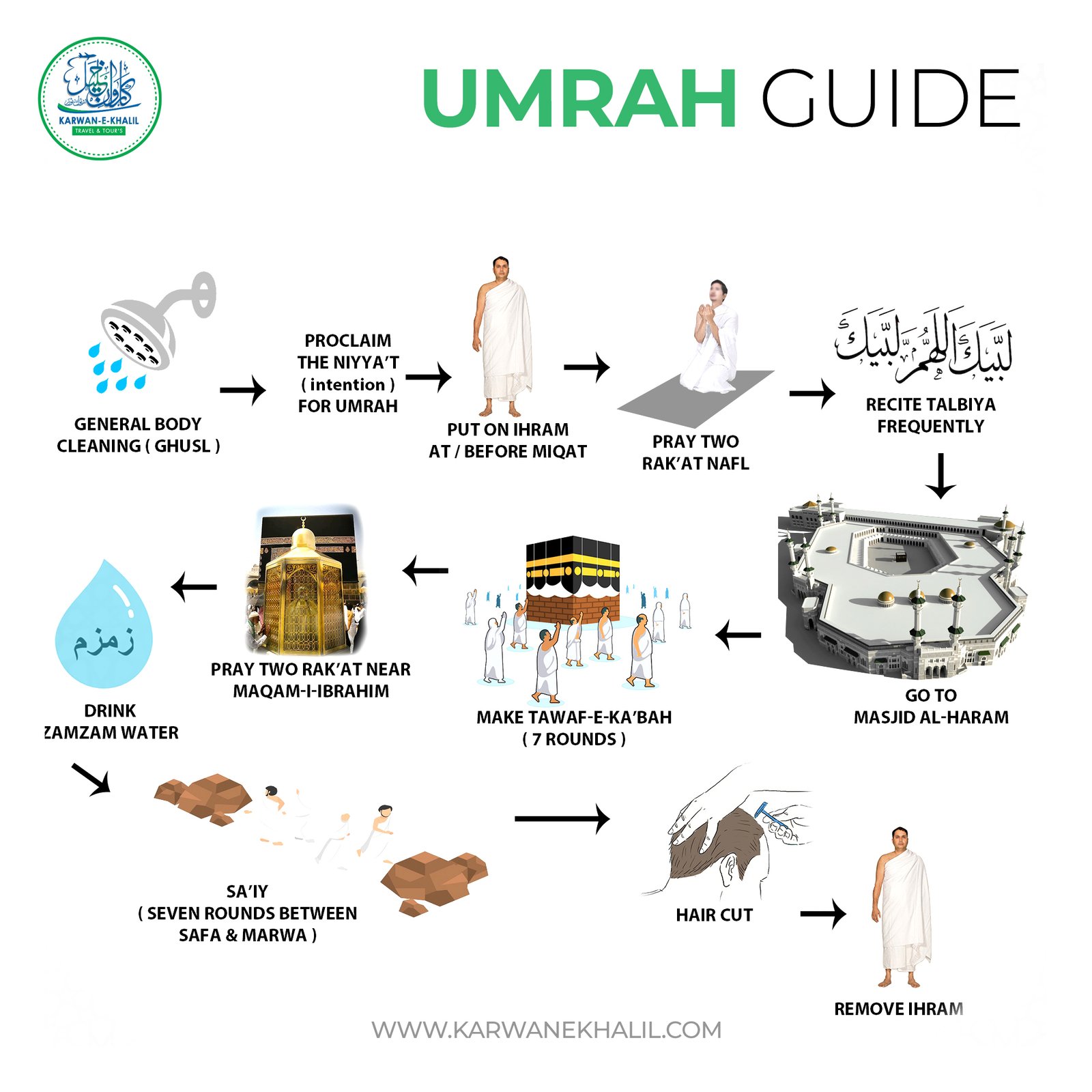Complete Guide to Performing Umrah
- Preparing for Ihram: Perform ghusl (ritual purification) and wear Ihram garments. For men, this includes two unstitched white cloths, and for women, modest Islamic clothing.
- Intention (Niyyah): Make the intention to perform Umrah and recite the Talbiyah ("Labbayk Allahumma labbayk…").
- It’s sunnah to perform two rak’ahs of salah before entering into the state of Ihram. This can be performed at home, after getting changed at the airport or in-flight before crossing the Miqat, provided there are prayer facilities on board. If you’re in Madinah, you can perform the prayer in your hotel, in Masjid Nabawi, at the designated Miqat point or on the train. Observe the prayer with the intention of performing two rak’ahs nafl for Ihram.
- The niyyah for Umrah should be made at the Miqat or close to it as you move in its direction. Ideally, you should delay making the intention until the last moment so you aren’t restricted by its prohibitions for longer than need be.
لَبَّيْكَ اَللَّهُمَّ عُمْرَةً ❁
Labbayka Llāhumma ʿUmrah.
O Allah, here I am to perform Umrah.
اَللَّهُمَّ إِنِّي أُرِيدُ الْعُمْرَةَ ❁
Allāhumma innī urīdu l-ʿUmrah.
O Allah, I intend to perform Umrah.
اَللَّهُمَّ إِنِّي أُرِيدُ الْعُمْرَةَ فَيَسِّرْهَا لِي وَتَقَبَّلْهَا مِنِّي ❁
Allāhumma innī urīdu l-ʿUmrata fa yassirhā lī wa taqabbalhā minnī.
O Allah, I intend to perform Umrah, so make it easy for me and accept it from me.
Talbiyah
The sunnah method of reciting the Talbiyah is to briefly pause at four places, indicated by the dashes. The prayer is as follows:
You must recite the Talbiyah at least once after making your intention for Umrah. Failure to do so will result in an invalid Umrah!
It is recommended to send Salawat on the Prophet ﷺ after reciting the Talbiyah and to make du’a for yourself and others. Continue reciting the Talbiyah for the rest of your journey until you reach one of the doors of Masjid al-Haram prior to performing Tawaf.
Haram of Makkah
The Haram of Makkah is a sacred area that extends several miles around Masjid al-Haram in all directions. In this area, it is forbidden to:
- Cut or damage grass, trees or any other type of vegetation.
- Harm or kill wild animals. This includes scaring away pigeons and other birds.
- Carry weapons.
- Fight or behave in a way that will violate the sanctity of this area.
Although you’re unlikely to breach one of these rules, keep in mind the sanctity of Makkah.
Entering Makkah
As you reach the limits of the Haram, constantly recite the Talbiyah, do dhikr and send Salawat upon the Prophet ﷺ. Recital of the following du’a is recommended upon entering the Haram:
اَللَّهُمَّ هَذَا حَرَمُكَ وَأَمْنُكَ فَحَرِّمْنِي عَلَى النَّارِ ❁ وَأَمِنِّي مِنْ عَذَابِكَ يَوْمَ تَبْعَثُ عِبَادَكَ ❁ وَاجْعَلْنِي مِنْ أَوْلِيَائِكَ وَأَهْلِ طَاعَتِكَ ❁
Allāhumma hādhā ḥaramuka wa amnuka fa ḥarrimnī ʿala n-nār, wa aminnī min ʿadhābika yawma tabʿathu ʿibādak, wa jʿalnī min awliyā’ika wa ahli ṭāʿatik.
O Allah, this is Your sanctuary and security, so make me unlawful to the hellfire, make me safe from Your punishment on the day You resurrect Your servants, and make me one of Your friends and one of the people who obey You.
Entering Masjid al-Haram
بِسْمِ اللهِ ❁ اَللَّهُمَّ صَلِّ عَلَى مُحَمَّدٍ ❁ اللّٰهُمَّ اغْفِرْ لِي وَافْتَحْ لِي أَبْوَابَ رَحْمَتِكَ ❁
Bismi Llāh. Allāhumma ṣalli ʿalā Muḥammad. Allāhumma-ghfir lī wa-ftaḥ lī abwāba raḥmatik.
In the name of Allah, send prayers upon Muhammad ﷺ. O Allah, forgive me and open for me the doors of Your Mercy.
أَعُوذُ بِاللهِ الْعَظِيمِ ❁ وَبِوَجْهِهِ الْكَرِيمِ ❁ وَسُلْطَانِهِ الْقَدِيمِ ❁ مِنَ الشَّيْطَانِ الرَّجِيمِ ❁
Aʿūdhu bi-Llāhi l-aẓīm, wa bi-wajhihi l-karīm, wa sulṭānihi l-qadīm, mina sh-shayṭāni r-rajīm.
I seek protection in Allah the Tremendous, His Noble Countenance, and His pre-eternal Sovereign Might from Shaytan the rejected.
- Don’t perform Tahiyyat al-Masjid (the Prayer for Greeting the Mosque) if you intend to; your Tawaf will suffice as the “greeting” for Masjid al-Haram.
- If you don’t have the intention of performing Tawaf immediately, you may perform Tahiyyat al-Masjid.
- In Masjid al-Haram, it is permissible for anyone to walk across those performing salah. However, their place of prostration should be avoided.
First Sight of the Kaaba
Du’a is suspended between heaven and earth and none of it is taken up until you send blessings upon your Prophet ﷺ.
[Narrated in Sunan al-Tirmidhi]
Recite the following three times:
اللّٰهُ أَكْبَرُ ❁ اللّٰهُ أَكْبَرُ ❁ لَآ اِلَهَ اِلَّا اللّٰهُ ❁
Allāhu akbar. Allāhu akbar. Lā ilāha illa Llāh.
Allah is the Greatest. Allah is the Greatest. There is no God except Allah.
It’s a sunnah to recite the following du’as:
اَللَّهُمَّ زِدْ هَذَا الْبَيْتَ تَشْرِيفاً وَتَعْظِيماً وَتَكْرِيماً وَمَهَابَةً ❁ وَزِدْ مَنْ شَرَّفَهُ وَكَرَّمَهُ مِمَّنْ حَجَّهُ أَوْ اعْتَمَرَهُ تَشْرِيفاً وَتَكْرِيماً وَتَعْظِيماً وَبِرّاً ❁
Allāhumma zid hādha l-bayta tashrīfan wa taʿẓīman wa takrīman wa mahābah, wa zid man sharrafahu wa karramahu mimman ḥajjahu aw iʿtamarahu tashrīfan wa takrīman wa taʿẓīman wa birrā.
Allah, increase this House in honour, esteem, respect and reverence. And increase those who honour and respect it—of those who perform Hajj or Umrah—in honour, respect, esteem and piety.
اَللَّهُمَّ أَنْتَ السَّلاَمُ ❁ وَمِنْكَ السَّلَامُ ❁ حَيِّنَا رَبَّنَا بِالسَّلاَمِ ❁
Allāhumma anta s-salām, wa minka s-salām, ḥayyinā rabbanā bi s-salām.
O Allah, You are Peace and from You is peace. Make us live, Lord, in peace.
Do dhikr, make du’a and send Salawat upon the Prophet ﷺ in abundance here. Make the most of this opportunity before you begin your Tawaf, especially if it’s the first time you’ve set eyes on the Kaaba.
Tawaf al-Umrah
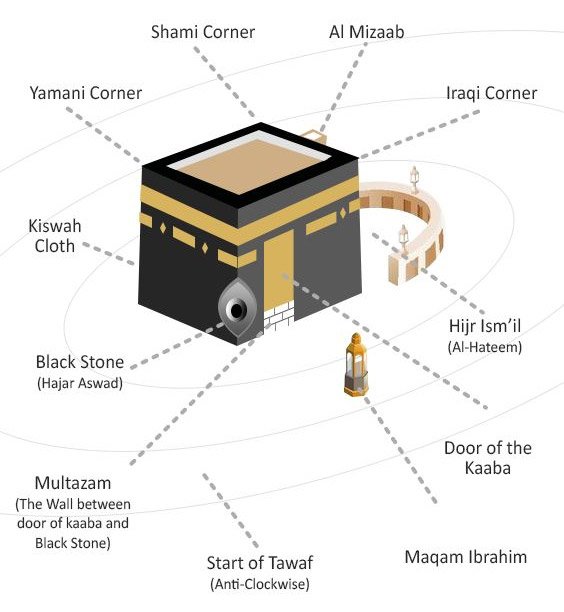
- To perform Tawaf yourself.
- To make an intention (verbally or not).
- To do Tawaf in Masjid al-Haram.
- To be in a state of wudhu and free of anything that requires ghusl, e.g. menstruation.
- To conceal the awrah.
- To start Tawaf from Hajar al-Aswad.
- To move in an anti-clockwise direction.
- To avoid the Hatim (the semi-circle area outside the Kaaba).
- To perform Tawaf by foot, for those who are able.
- To perform seven circuits.
- To perform two rak’ahs of salah after the Tawaf.
Preparation
Ensure you’re in a state of wudhu, and if you’re a male, uncover your right shoulder by passing the top sheet of your Ihram under your right armpit, allowing the garment to hang over your left shoulder (Idtiba).
Starting Point
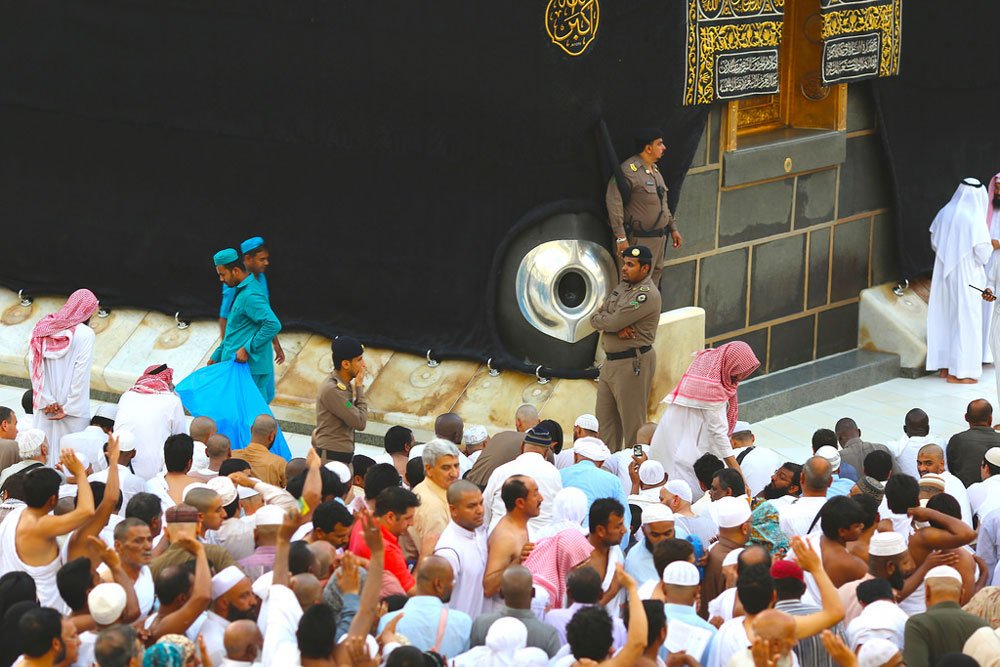
Position yourself in line with the corner of the Kaaba where the Hajar al-Aswad is situated. This corner is the one that faces a single minaret (the other three corners face two minarets). There is a green light on the wall of the Masjid opposite the Kaaba, which indicates where the Tawaf starts from. This is the starting point of each shawt (circuit). Stand just before this starting point facing the Kaaba.
Intention
As with any other act of worship, make the niyyah to perform Tawaf solely for Allah. You may also ask for acceptance and ease of your Tawaf. The following words may be said:
O Allah, I intend to perform the Tawaf of Umrah of the Kaaba for your sake and your sake alone. Please accept it from me and make it easy for me.
You may make the following intention, which is in Arabic:
اَللَّهُمَّ إِنِّي أُرِيدُ طَوَافَ بَيْتِكَ الْحَرَامِ فَيَسِّرْهُ لِي وَتَقَبَّلْهُ مِنِّي ❁
Allāhumma innī urīdu l-ṭawwafa baytika l-ḥarāmi fa yassirhu lī wa taqabbalhu minnī.
O Allah, I intend to perform Tawaf of your Sacred House, so make it easy for me and accept it from me.
The niyyah doesn’t have to be verbal.
Kissing, Touching or Saluting the Hajar al-Aswad (Istilam)
Although kissing the Hajar al-Aswad is very virtuous, it’s almost impossible to reach it. Don’t harm others around you in an attempt to get to it.
- Kissing – If you reach the Hajar al-Aswad, place your hands on it, put your face between your hands, and say “Bismi Llāhi wa Llāhu akbar (بِسْمِ اللّٰهِ وَاللّٰهُ أَكْبَرُ)” and kiss it lightly. Some scholars have said it is preferable to kiss it three times if you have the chance.
- Touching – If you’re in reaching distance but unable to kiss it, touch it with your hand(s) and kiss your hand(s).
- Saluting – If it isn’t possible to reach the stone, as is likely to be the case, perform a symbolic Istilam from afar by directly facing the Hajar al-Aswad and raising your hands up to your earlobes (as you would do when starting salah). Ensure your palms are also facing it, as though your face and hands are on the Hajar al-Aswad, and say “Bismi Llāhi wa Llāhu akbar (بِسْمِ اللّٰهِ وَاللّٰهُ أَكْبَرُ).” You may kiss your palms if you wish.
If you decide to attempt to kiss or touch the Hajar al-Aswad, it is important to be aware that the experience can be intense. Due to the large number of people gathered around it, there is often a significant amount of pushing and shoving, which can potentially lead to injuries. It is nearly impossible to reach the Hajar al-Aswad without having to force your way through people vying to reach the sacred stone. Therefore, it’s recommended you remain safe and perform Istilam by saluting.
The following supplication, a du’a of Ali I, may be recited when coming parallel to the Hajar al-Aswad in each circuit:
بِسْمِ اللّٰهِ وَاللّٰهُ أَكْبَرُ ❁ اَللَّهُمَّ إِيمَاناً بِكَ وَتَصْدِيقاً بِكِتَابِكَ ❁ وَوَفَاءً بِعَهْدِكَ ❁ وَاتِّبَاعاً لِسُنَّةِ نَبِيِّكَ مُحَمَّدْ ❁
Bismi Llāhi wa Llāhu akbar. Allāhumma īmānan bika wa taṣdīqan bi kitābik, wa wafāʿan bi ʿahdik, wattibāʿan li sunnati nabiyyika Muḥammad ﷺ.
In the name of Allah, Allah is the Greatest. O Allah, out of faith in You, conviction in Your book, in fulfilment of Your covenant and in emulation of Your Prophet’s sunnah ﷺ.
Other forms of dhikr, such as Tahlil (lā ilāha illa Llāh) and Salawat upon the Prophet ﷺ, may also be uttered at this point.
Start the Tawaf
Turn to your right and start the first circuit of your Tawaf, ensuring the Kaaba is on your left. Proceed in an anti-clockwise direction and avoid walking through the Hijr Ismail. If you happen to walk through it, the circuit won’t count, and it will have to be repeated.
Raml
In the first three circuits, men should perform Raml, which is the practice of walking briskly, lifting the legs forcefully and sticking out the chest. However, if there is congestion, which is likely to be the case if you’re closer to the Kaaba, only perform this sunnah if you’re sure you won’t harm or inconvenience others. During peak times, you’re unlikely to be able to perform this action.
Dhikr & Du’a
During your Tawaf, you may recite prayers and supplications of your choice. Du’as are accepted during Tawaf, so make the most of the occasion and remember Allah with sincerity and devotion. It’s perhaps advisable not to read from a du’a book, especially if you don’t understand the Arabic. Imam Ibn Hibban V said:
Specifying a du’a would take the moment away, because with specific du’as, one will merely be repeating words, whereas this occasion is for any du’a and for remembering one’s Lord with humility and sincerity.
Therefore, you should supplicate in any language and in any manner that you prefer. If you want to make Quranic and Prophetic supplications during your Tawaf, make an effort to memorise and learn the meanings of them. Reciting Quran and sending Salawat upon the Prophet ﷺ during Tawaf is also recommended.
Rukn al-Yamani
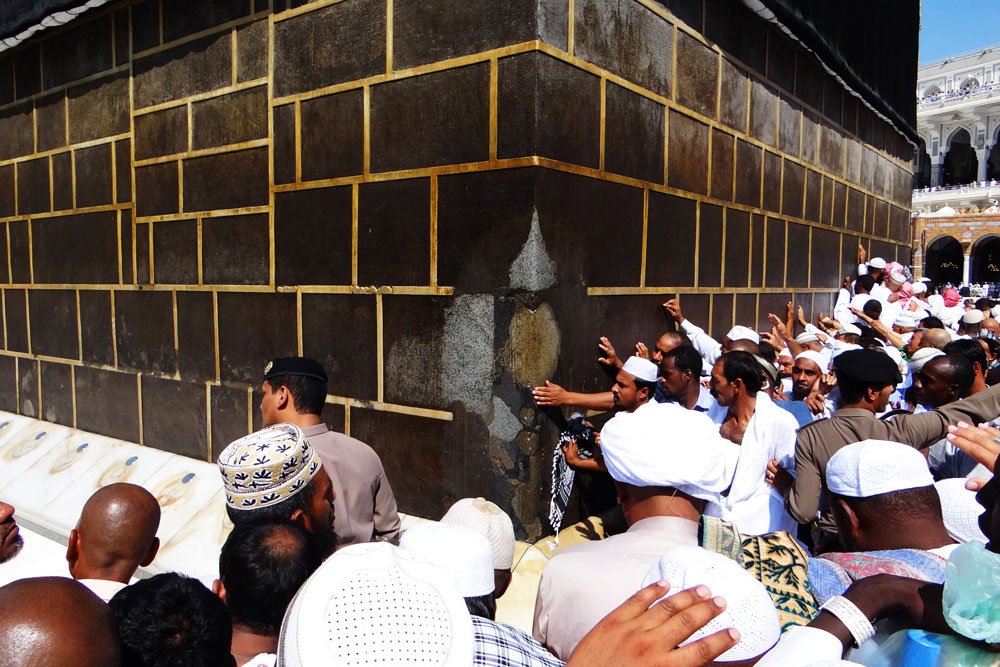
Upon reaching the Rukn al-Yamani (the Yemeni Corner), the corner preceding the Hajar al-Aswad, if you manage to get close enough, touch it with your right hand or both hands and say “Allāhu akbar (اللّٰهُ أَكْبَرُ)”. If there’s too much congestion, as is likely to be the case, proceed without saying Takbir or gesturing towards it.
It is a sunnah to recite the following du’a between the Rukn al-Yamani and the Hajar al-Aswad:
رَبَّنَا آتِنَا فِي الدُّنْيَا حَسَنَةً وَفِي الْآخِرَةِ حَسَنَةً وَقِنَا عَذَابَ النَّارِ ❁
Rabbanā ātinā fi d-dunyā ḥasanatan wa fi l-ākhirati ḥasanatan wa qinā ʿadhāba n-nār.
O our Lord, grant us the good of this world, the good of the Hereafter, and save us from the punishment of the fire.
[Surah al-Baqarah, 2:201]
Imam Shafi’i V recommended reciting this du’a throughout the Tawaf.
End of Circuit at the Hajar al-Aswad
Returning to Hajar al-Aswad marks the completion of one circuit. Begin the second by doing Istilam of Hajar al-Aswad as previously described and saying “Allāhu akbar (اللّٰهُ أَكْبَرُ)”. You should say Allāhu akbar while doing Istilam in all subsequent circuits. You will be performing Istilam eight times in total during the Tawaf, one before the start of the Tawaf and one at the end of each of the seven circuits.
During Tawaf
The Tawaf should be completed in a continuous manner with no interruptions between circuits. However, if a congregational prayer is due to start, you must join the congregation and resume your Tawaf from the position that you stopped. The circuit need not be repeated. These rules also apply if you need to repeat your wudhu.
Complete the Tawaf
Proceed in the same manner until you have completed seven circuits. Performing Istilam at the start of Tawaf and the end is a highly emphasised sunnah, and performing Istilam on the other six occasions is desirable.
Salah
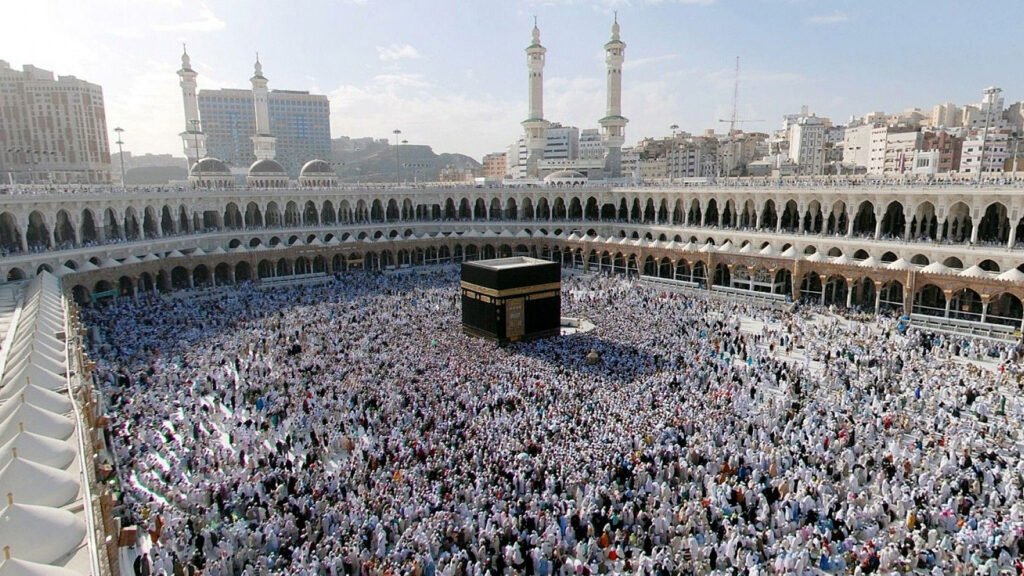
Upon finishing the Tawaf, perform two rak’ahs of salah, preferably in a position where Maqam Ibrahim is between you and the Kaaba. However, keep in mind that since Maqam Ibrahim is situated within the mataf, there is often nowhere for pilgrims performing Tawaf to move except around and almost over the top of those praying just beyond Maqam Ibrahim, resulting in a great deal of congestion. If it isn’t possible to perform the prayer there due to crowding, it can be performed anywhere in Masjid al-Haram.
While moving to the place where you intend to perform the two rak’ahs, it is recommended to audibly recite the following:
وَاتَّخِذُوا مِنْ مَقَامِ إِبْرَاهِيمَ مُصَلًّى ❁
Wattakhidhū min maqāmi Ibrāhīma muṣalla.
And take the Maqam Ibrahim as a place of salah.
[Surah al-Baqarah, 2:125]
It is sunnah to recite Surah al-Kafirun (Surah 109) in the first rak’ah and Surah al-Ikhlas (Surah 112) in the second, after Surah al-Fatiha. Make sure you make plenty of du’a after completing the prayer.
Zamzam
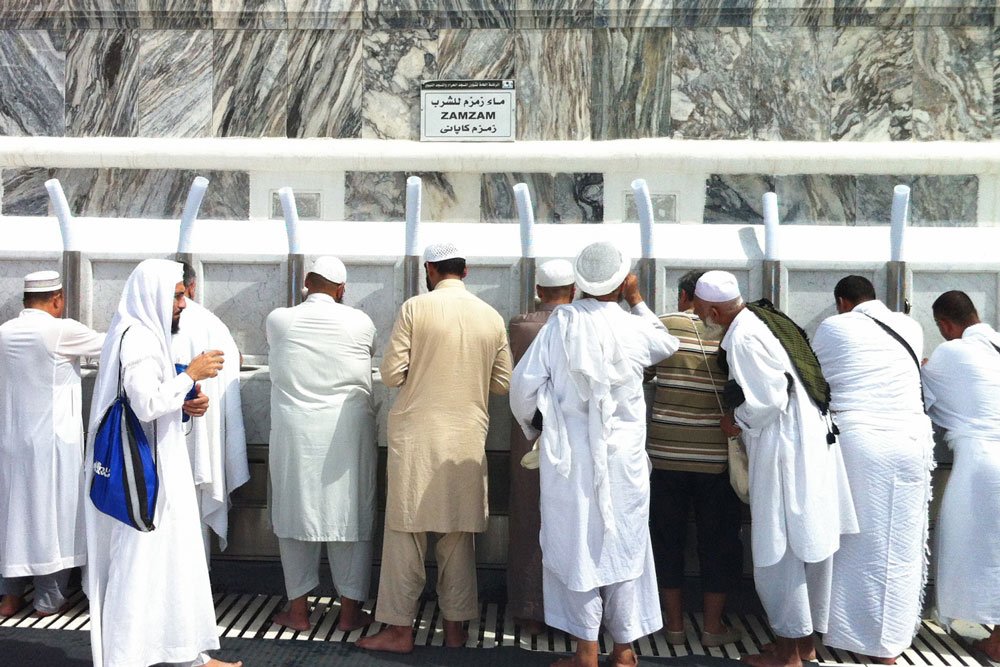
After completing salah and making du’a, drink your fill of Zamzam water, which is available around the Tawaf area and from various water fountains and dispensers in Masjid al-Haram. The entrance to the old well of Zamzam has been covered to allow for more room to do Tawaf.
The Prophet ﷺ said: “The water of Zamzam is for whatever purpose it is drunk for.” Before drinking the Zamzam water, make an intention that its consumption will be a means of fulfilling your wishes, whether that is good health, success in this world, or protection from the tribulations of the grave. When drinking the water, it is mustahabb to stand and face the Kaaba, say Bismillah, pause to take a breath three times, and say Alhamdulillah after finishing. You can also rub it on your face and body. You may recite the following du’a after drinking the water:
اللّٰهُمَّ إِنِّي أَسْأَلُكَ عِلْمًا نَافِعًا ❁ وَرِزْقًا وَاسِعًا ❁ وَعَمَلًا مُتَقَبَّلًا ❁ وَشِفَاءً مِنْ كُلِّ دَاءٍ ❁
Allāhumma innī as’aluka ʿilman nāfiʿa, wa rizqan wasiʿa, wa ʿamalan mutaqabbala, wa shifā’an min kulli dā’.
O Allah, I ask You for knowledge that is beneficial, provision that is abundant, accepted deeds, and a cure for every illness.
You may also make any other supplication of your choosing as it’s another station where du’as are accepted.
Multazam

After you have finished drinking Zamzam water, you may proceed to the Multazam, which is the area between Hajar al-Aswad and the door of the Kaaba.
The Multazam is almost impossible to get to during Hajj season due to the large crowds that gather. However, it is sometimes accessible during other parts of the year.
If it is possible to reach the Multazam, raise your hands above your head, cling to the wall and press your chest and cheeks against it. It is a sunnah of the Prophet ﷺ and yet another station where supplications are accepted, so you should lengthen your du’a here.
If you can’t reach the Multazam due to the crowds, you may face it and supplicate from a distance.
Sa’i
It is a sunnah to perform Sa’i immediately after Tawaf, although you may take a break if necessary. If you feel tired after Tawaf or your feet are aching, you may rest until you feel ready. Remember, you will cover over three kilometres during Sa’i, so ensure you have sufficient energy to complete the rite before starting.
For the Sa’i to be considered valid, the following is necessary:
- To perform Sa’i yourself.
- To have entered into Ihram before performing the Sa’i.
- To stay in Ihram until the Sa’i has been completed.
- To perform Sa’i at its correct time.
- To begin Sa’i at Safa and finish at Marwa.
- To perform Sa’i after having done Tawaf.
- To perform Sa’i on foot unless you have a valid excuse.
- To perform seven laps.
- To cover the complete distance between Safa and Marwa.
Istilam of the Hajar al-Aswad
Before Sa’i, it is sunnah to do Istilam of Hajar al-Aswad one last time. This will be the ninth time, following the eight times you performed Istilam during Tawaf.
If you’ve forgotten to perform this Istilam, or you’re finding it difficult to return to the line of the Hajar al-Aswad due to crowding or tiredness, it may be omitted. However, you can do Istilam anywhere else in Masjid al-Haram, as long as you’re facing the Hajar al-Aswad.
Proceed to Safa
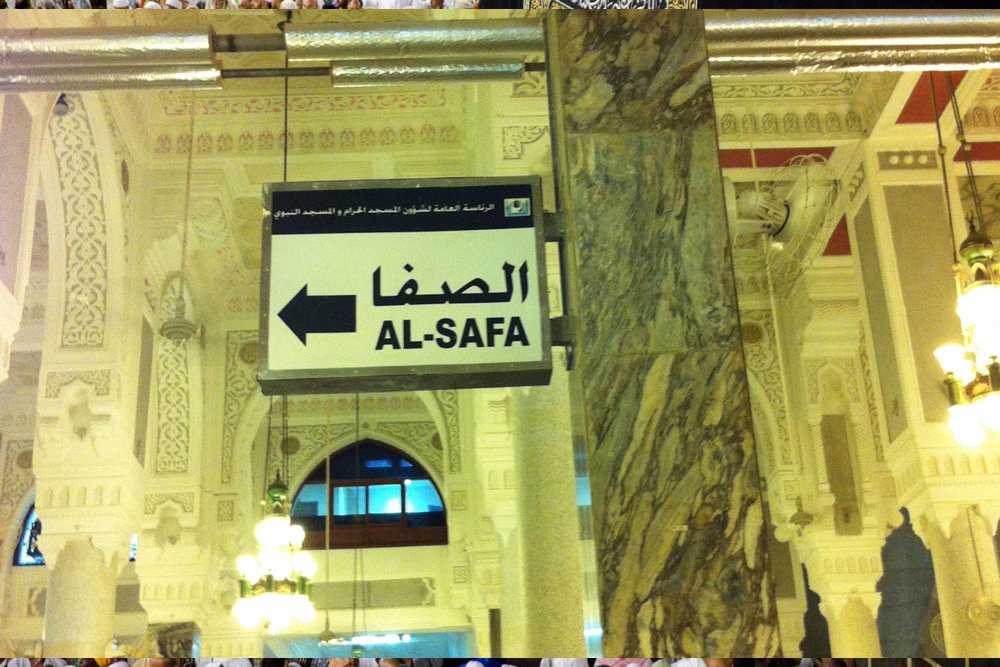
Proceed to the hill of Safa, which is located inside Masjid al-Haram, in line with the Hajar al-Aswad. There are signs which indicate where it is. As you’re approaching Safa, it is sunnah to recite the following:
إِنَّ الصَّفَا وَالْمَرْوَةَ مِنْ شَعَائِرِ الله ❁
Inna ṣ-Ṣafā wa l-Marwata min shaʿā’iri Llāh.
Indeed, Safa and Marwa are from the Signs of Allah.
[Surah al-Baqarah, 2:158]
أَبْدَأُ بِمَا بَدَأَ اللهُ بِهِ ❁
Abda’u bimā badā’ Llāhu bih.
I begin with that which Allah has begun with.
These should only be recited once before Sa’i and not at the start of each lap.
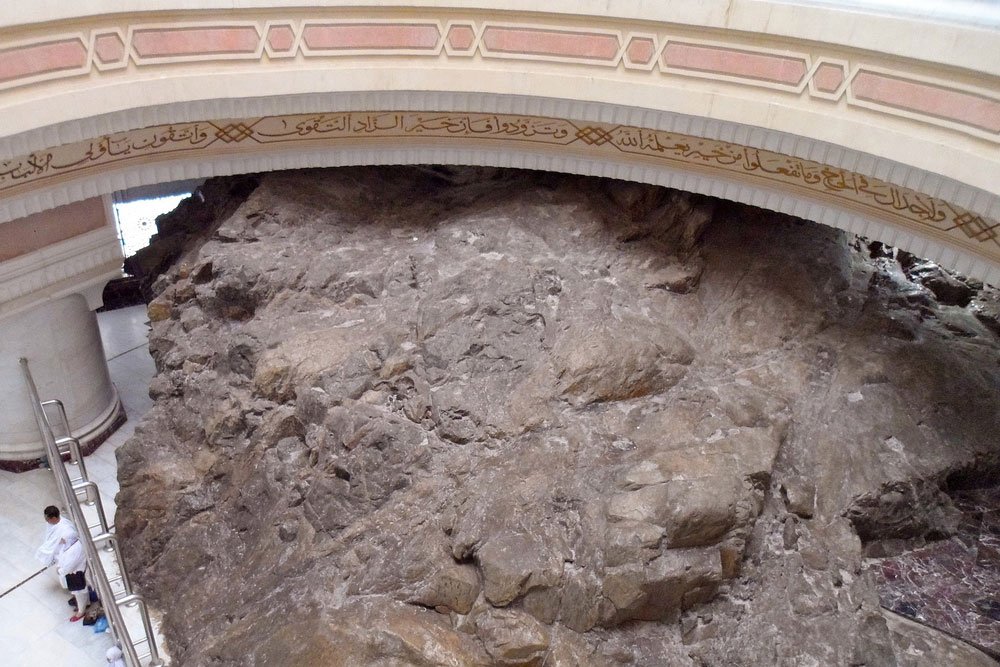
Make Du’a at Safa
Upon reaching the hill of Safa, face the direction of the Kaaba and raise your hands in supplication. Don’t raise your hands up to your earlobes or gesture towards the Kaaba as you would have done during Tawaf. You may say Takbir (Allāhu akbar), Tahlil (lā ilāha illa Llāh) and send Salawat upon the Prophet ﷺ.
It is sunnah to recite the following du’a:
اللّٰهُ أَكْبَرُ ❁ اللّٰهُ أَكْبَرُ ❁ اللّٰهُ أَكْبَرُ ❁ وَلِلّٰهِ الْحَمْدُ ❁
Allāhu akbar, Allāhu akbar, Allāhu akbar, wa li Llāhi l-ḥamd.
Allah is the Greatest; Allah is the Greatest; Allah is the Greatest, and to Allah belongs all praise.
لَآ إِلٰهَ إِلَّا اللّٰهُ وَحْدَهُ لاَ شَرِيكَ لَهُ ❁ لَهُ الْمُلْكُ وَلَهُ الْحَمْدُ ❁ يُحْيِي وَيُمِيتُ ❁ وَهُوَ عَلَى كُلِّ شَيْءٍ قَدِيرٌ ❁
La ilāha illa Llāhu waḥdahu la sharīka lah, lahu l-mulku wa lahu l-ḥamd, yuḥīī wa yumīt, wa huwa ʿalā kulli shay’in qadīr.
There is no deity except Allah, alone without a partner. To Him belongs the Dominion, and to Him belongs all praise. He gives life and death, and He has power over everything.
لَآ إِلٰهَ إِلَّا اللّٰهُ وَحْدَهُ ❁ اَنْجَزَ وَعْدَهُ وَنَصَرَ عَبْدَهُ وَهَزَمَ اَلْأَحْزَابَ وَحْدَهُ ❁
La ilāha illa Llāhu waḥdah, anjaza waʿdahu wa naṣara ʿabdahu wa hazama l-aḥzāba waḥdah.
There is no deity except Allah alone. He fulfilled His promise, supported His slave and defeated the Confederates alone.
After reciting this du’a, you may recite your own supplications. Read the du’a a total of three times, making your own supplications in between each time, as was the sunnah of the Prophet ﷺ.
Proceed to Marwa
From Safa, make your way towards Marwa. Between Safa and Marwa, you will encounter two sets of green fluorescent lights approximately 50 metres apart, which indicate the distance that Hajar ran in order to get to higher ground. These two markers are known as Milayn al-Akhdharayn (the Two Green Mileposts). Between these two lights, it is sunnah for men to run at a medium pace while women should continue normally.

Dhikr & Du’a
No fixed dhikr or du’a has been prescribed to be read during Sa’i, so you may recite any prayers or supplications of your choice and send Salawat upon the Prophet ﷺ.
Make Du’a at Marwa
Upon reaching the hill of Marwa, face the direction of the Kaaba, raise your hands in supplication and repeat the same supplications you recited at Safa.
This completes one lap of Sa’i. Returning back to Safa is considered a second lap.
End of Sa’i
Repeat this procedure until you have completed seven laps, at which point you should be at the hill of Marwa.
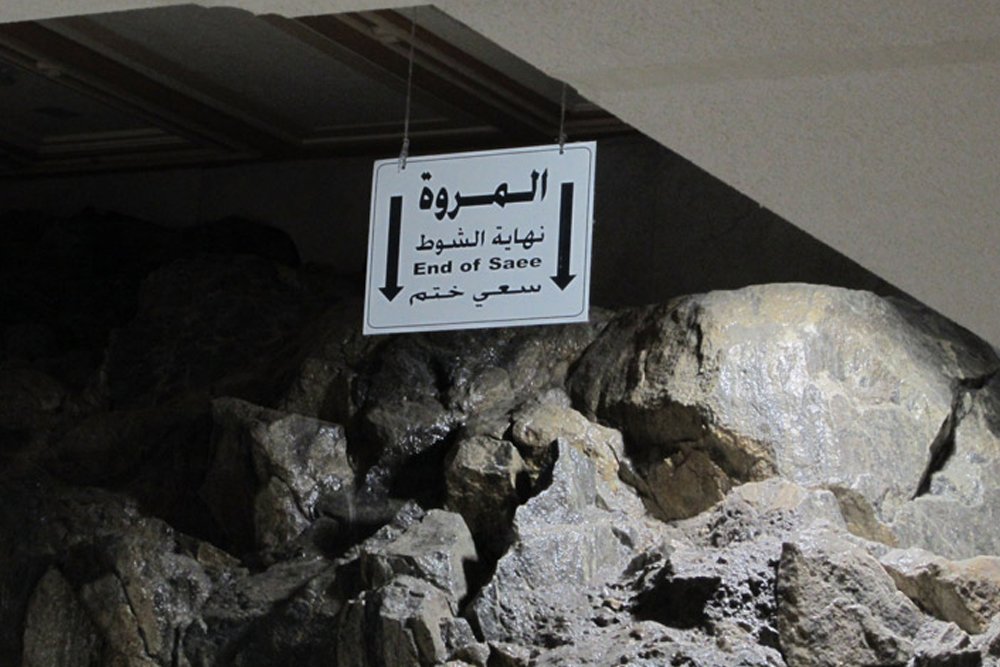
Dua and Salah
It is recommended that you make a final du’a here and perform two rak’ahs of nafl salah in Masjid al-Haram following Sa’i.
Leave the Haram
As you leave Masjid al-Haram, step out with your left foot and recite the following du’a, as was the sunnah of the Prophet ﷺ when leaving the mosque:
بِسْمِ اللهِ وَالصَّلَاةُ وَالسَّلَّامُ عَلَى رَسُولِ اللهِ ❁ اللّٰهُمَّ إِنِّي أَسْأَلُكَ مِنْ فَضْلِكَ ❁
Bismi Llāhi wa ṣ-ṣalātu wa s-salāmu ʿalā rasūli Llāh. Allāhumma innī as’aluka min faḍlik.
In the name of Allah, and peace and blessings be upon the Messenger of Allah. O Allah, I ask of you from Your bounty.
Halq or Taqsir
After Sa’i, you must have your hair shaved (Halq) or trimmed by at least an inch (Taqsir) in order to leave the state of Ihram and complete your Umrah. It is more virtuous for a man to have his head shaved completely.
Women may only have their hair trimmed.
There are a number of licensed barbershops in Makkah, which are open 24 hours a day and generally only close during salah times. There are many barbershops in the Zamzam Towers, Hilton shopping complex and al-Safwa Towers. You will also see many barbers located outside the Marwa door after you finish Sa’i.
Alternatively, you may shave or trim your own hair in order to come out of the state of Ihram.
Congratulations on your Umrah!
- You are now free from the restrictions of Ihram, and you may change into regular clothing. If you plan on performing another Umrah, you must travel to the boundary of the Haram in order to once again enter into Ihram. Most pilgrims choose to enter into Ihram at Masjid Aisha, which is the nearest and most convenient location from Masjid al-Haram. Taxis are available near the mosque.



